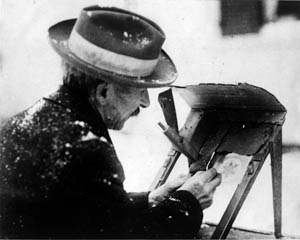Wilson Bentley facts for kids
Quick facts for kids
Wilson A. Bentley
|
|
|---|---|

Bentley at work
|
|
| Born |
Wilson Alwyn Bentley
February 9, 1865 Jericho, Vermont, United States
|
| Died | December 23, 1931 (aged 66) Jericho, Vermont, United States
|
| Nationality | American |
| Known for | Pioneering the study of atmospheric ice crystal formation and snowflake photography |
Wilson Alwyn Bentley (born February 9, 1865, died December 23, 1931) was an American scientist and photographer. People often called him Snowflake Bentley. He was the first person known to take clear, close-up pictures of snowflakes.
He found a special way to catch snowflakes on dark velvet. This helped him take their pictures before they melted or disappeared into the air (a process called sublimation). He also believed that no two snowflakes are exactly alike.
Even today, scientists use many of the same methods Bentley developed. His photos show how good he was, even with older equipment. His work was so amazing that few others tried to photograph snowflakes for nearly 100 years. The biggest collection of his photos is kept in his hometown of Jericho, Vermont.
Bentley gave his original glass-plate photos of snow crystals to the Buffalo Museum of Science. Some of these pictures have been made digital. You can now see them in an online library.
Contents
The Life of Wilson Bentley
Wilson Bentley was born on February 9, 1865, in Jericho, Vermont. He grew up on a farm. From a young age, he was very interested in snow crystals. He once said, "Always, right from the beginning it was the snowflakes that fascinated me most." He loved winter, even when other farm folks did not.
When he was 15, his mother gave him an old microscope. He tried to draw the snowflakes he saw through it. But the snowflakes were too detailed and melted too fast.
How He Photographed Snowflakes
Bentley came up with a clever idea. He attached a bellows camera to his microscope. After many tries, he took his first snowflake photo on January 15, 1885. This was a huge step!
He would catch each tiny crystal on a chalkboard. Then, he quickly moved it to a microscope slide. Even in very cold temperatures, snowflakes do not last long. They can disappear into the air, a process called sublimation.
Over his lifetime, Bentley took more than 5,000 pictures of snow crystals. Each one was unique.
Sharing His Discoveries
Bentley called snowflakes "tiny miracles of beauty" and "ice flowers." But he was also a careful scientist. He worked with George Henry Perkins, a professor from the University of Vermont. Together, they wrote an article saying that no two snow crystals are alike.
This idea became very popular. Bentley then wrote many articles for famous magazines. These included National Geographic, Nature, and Scientific American. His amazing photos were wanted by schools and museums all over the world.
In 1931, Bentley worked with William J. Humphreys from the U.S. Weather Bureau. They published a book called Snow Crystals. This book had 2,500 of Bentley's photographs. He also wrote about "snow" for the Encyclopædia Britannica.
Bentley did not just photograph snowflakes. He also took pictures of other forms of ice and water. This included clouds and fog. He was the first American to measure the size of raindrops. He was also one of the first scientists to study clouds.
His Final Days
Wilson Bentley died on December 23, 1931. He may have caught pneumonia while walking home in the snow. His famous book, Snow Crystals, came out just before he passed away. You can still find copies of his book today.
Bentley's Lasting Impact
Bentley's work left a big mark on science and art.
Honoring His Memory
A science center at Vermont State University in Johnson, Vermont, is named after him. His home where he lived his whole life is now a historic place. It is listed on the National Register of Historic Places.
In 1999, a children's book called Snowflake Bentley won the Caldecott Medal. This award is for the best-illustrated children's book. The book tells the story of Bentley's life.
The Fairbanks Museum and Planetarium in St. Johnsbury, Vermont, has a special exhibit. It shows how ice crystals form in the air. The exhibit features many of Bentley's photos and a short story about his life. Bentley was friends with Franklin Fairbanks, who founded the museum.
The Field Museum of Natural History in Chicago also has some of Bentley's old glass-plate negatives. They have used his techniques to create a guide from these 19th-century snowflake photos.
See also
 In Spanish: Wilson Bentley para niños
In Spanish: Wilson Bentley para niños
Other reading
- Blanchard, Duncan. The Snowflake Man, A Biography of Wilson A. Bentley, (Blacksburg, VA: McDonald and Woodward, 1998) ISBN: 0-939923-71-8.
- Martin, Jacqueline Briggs. Snowflake Bentley, (New York: Houghton Mifflin Co., 1998) ISBN: 0-395-86162-4 (a children's biography illustrated with woodcuts hand tinted with watercolors by Mary Azarian. Awarded the Caldecott Medal.)
- Stoddard, Gloria May. Snowflake Bentley: Man of Science, Man of God (Shelburne, VT: New England Press, 1985) ISBN: 0-933050-31-3 (Originally published in 1979 by Concordia Publishing House, ISBN: 0-570-03620-8).


